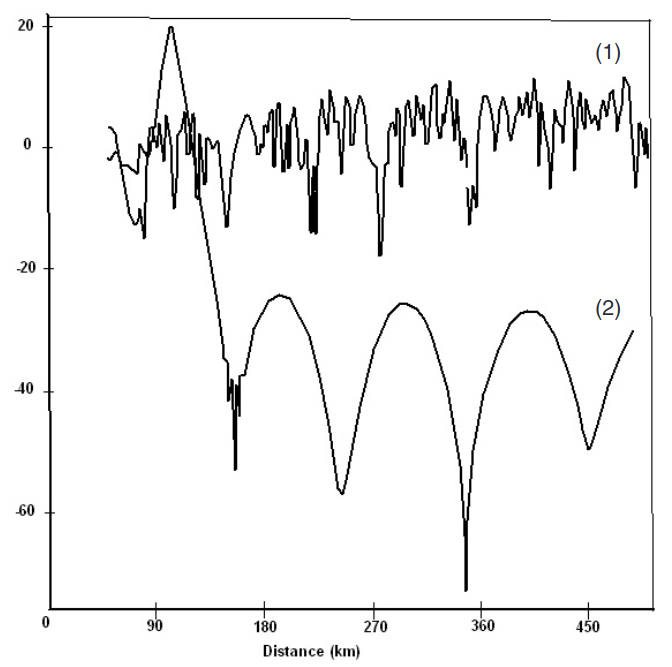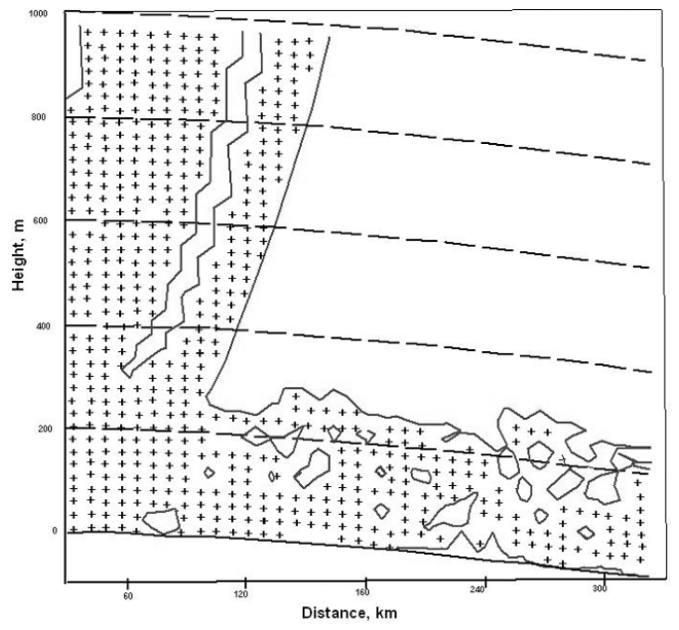Explore the impact of elevated M-inversions on UHF/EHF field propagation beyond the horizon, examining atmospheric effects and anomalous radio frequency behavior.
The elevated refractive layer, the so-called M-inversion, is frequently associated with an anomalousy high level of the received signal at UHF frequencies over the horizon. It is apparent that the methods of prediction of either the parameters of the elevated layer or the signal level are needed in many applications, such as radar, surveillance and communications.
The methods of the analytical solutions to the problem of wave propagation in the presence of elevated M-inversion are less well developed than those applied to propagation in an evaporation duct. The major reason for this is that such a waveguide has a multi-mode or multi-ray nature that, in turn, may require a different approach to obtaining the analytical solution, depending on the geometry of the problem (positions of the transmitter and receiver relative to the elevated duct “boundaries”, range and frequency).
In a sub-tropical region of the world’s oceans both evaporated and elevated ducts may exist simultaneously thus complicating the situation. In Refs this situation is analysed by applying the normal wave method to the M-profile approximated by a piece-wise linear profile. An alternative approach is described in Hybrid Representation in Action: Fock’s Contour Integral and the Attenuation Factor“Exploring Hybrid Representation for the Attenuation Factor”, where the contribution of evaporation duct is presented by trapped modes while the reflection from elevated M-inversion is analysed in terms of geometric optics.
The modal representation of the wave field for the case of elevated M-inversion is presented in this article. Hybrid Representation in Action: Fock’s Contour Integral and the Attenuation Factor“Exploring Hybrid Representation for the Attenuation Factor” introduces the hybrid, ray and modes, representation of the wave field in the problem of a two-channel system. Some results of the measurements versus prediction are discussed in Comparison of Experimental Results with the Deterministic Theory of Elevated Duct Propagation“Deterministic Theory and Results of Elevated Duct Propagation” and, finally, in Comparison of Experimental Results with the Deterministic Theory of Elevated Duct Propagation“Deterministic Theory and Results of Elevated Duct Propagation”, we introduce a method of estimating the excitation of the elevated duct due to scattering of the direct wave on the fluctuations in refractivity in the vicinity of the upper boundary of the atmospheric boundary layer.
Modal Representation of the Wave Field for the Case of Elevated M-inversion
Consider a piece-wise linear model of the M-profile as shown in Figure 1 and introduce the dimensionless coordinates ξ = mx/a, h = kz/m.

The parameters of the M-profile can be expressed in terms of h-coordinates and the scaled potential U(h) = 2m210-6M(z):
- Hk = kZk/m;
- Hi = kZi/m;
- Hs = kZs/m;
- Uk = 2m210-6M(Zk);
- Ui = 2m210-6M(Zi);
- U0 = 2m210-6ΔM.
Let us also introduce the gradients of the M-profile in each of the layers between Zs, Zi and above Zk respectively:
- G2 = dM/dz, with Zs < z < Zi;
- G4 = dM/dz, with z > Zk.
The respective gradients of the dimensionless profile U(h) are given by:
Following the approach described in Understanding Parabolic Approximation in Wave Propagation: Analytical Methods and Applications“Parabolic Approximation to the Wave Propagation”, we expand the attenuation factor W(ξ, h, h0) over the set of eigenfunctions of a continuum spectrum. Using the results of Green Function for a Parabolic Equation in a Stratified Medium“Parabolic Approximation to the Wave Propagation” and introducing the dimensionless “energy” t = m2E/k2 we obtain:
where the eigenfunction Ψ(t, h) obeys the equation:
and the boundary conditions:
As known from analogy with a quantum-mechanical problem, the solution to Eq. (2) is given by a superposition of the waves, outgoing (χ+) to infinity (h → ∞) and incoming (χ–) from infinity:
Given the linear approximation to the M-profile in each of the layers: Hs < h ≤ Hi Hs < h ≤ Hi, Hi < h ≤ Hk and h > Hki the solution for χ± can be presented via superposition of the Airy–Fock function. Taking into account the continuity of both the function v and its derivative at the boundaries of the layers with constant gradient of U(h), the outgoing wave can be written as follows:
1 With h > Hk:
2 with hk ≥ h > hi:
where:
Here:
is a reflection coefficient of the wave incident to the boundary h = Hk from h < Hk, the parameter Qk is the surface impedance at the boundary h = Hk and is given by:
3 with Hi ≥ h > Hs:
where:
Here:
the other parameters have the same meaning as above.
4 With h ≤ Hs:
where:
The solution to W(ξ, h, h0) is obtained in principle and given by Eqs. (1)–(18). However, the direct calculation of Eq. (1) is not practical because of the problem of convergence. Therefore, a significant amount of research has been dedicated to finding effective methods of calculating the electromagnetic field in the presence of elevated M-inversion.
Here we consider a modal representation of the attenuation function W(ξ, h, h0) in a two-channel system when both elevated and surface-based M-inversion are present. In this approach, UHF Propagation in an Evaporation Ductthe integral is calculated as a sum of the residue at the poles of the S-matrix in the upper half-space of variable t. Taking into account Eqs. (5)–(18) we obtain the expression for the S-matrix in this particular problem:
where:
- Rg = -w1(x0)/w2(x0) is the reflection coefficient of the ground;
is the reflection coefficient of the wave incoming from the upper space from the boundary h = Hs with ideal boundary conditions on it;
is a similar coefficient of reflection from the boundary h = Hs,but for the wave incoming from the space below the boundary h = Hs.
The resonant terms in the denominator of the S-matrix determine the spectrum of the normal waves in a two-channel system. Apparently, the propagation constants of the normal waves are defined by the position of the poles of the S-matrix in the t-plane. The waves trapped in an evaporation duct (surface-based M-inversion) have propagation constants tn in the interval Re tn ∈ (0, U0). Waves localised in the elevated duct between Hs and Hk have propagation constants tn in the interval Re tn ∈ (0, Ui). And, finally, the normal waves localised in a channel formed by the ground surface h = 0 and the upper boundary of the elevated layer h = Hk are in the interval Re tn ∈ (Uk, 0).
and Eq. (20) can then be reduced to 1+Ri = 0. Assume that the propagation constants of interests are such that:
These normal waves experience complete reflection from the boundary h = Hk, in fact the respective rays turn back long before reaching the boundary Hk. The reflection coefficient can then be estimated as Rk ≈ -1. Taking into account Eq. (12) for Ri we can obtain instead of Eq. (20) the following characteristic equation for the waves trapped in an elevated duct:
where:
Equation (21) can be further simplified using the asymptotic formulas for the Airy function v. The result is given by:
where:
The solution to Eq. (22) provides a spectrum of the propagation constants tn of the elevated duct:
As observed, Eq. (23) is obtained by neglecting the leaking of the modes into the space outside the duct. The number N1 of trapped modes is limited by the condition tn > Uk, therefore:
Let us consider another situation and assume now that Uk < 0. We pay attention to the modes of the channels formed by the earth’s surface h = 0 and the upper boundary of the M-inversion, h = Hk. As discussed above, the propagation constants of these modes lie in the interval Re tn ∈ (Uk, 0). The spectrum of the propagation constant is determined by the characteristic equation 1 – RsRg = 0. Using asymptotic expressions for Airy functions we obtain:
where:
Let us expand the term D into a series:
The series (27) takes into account the multiple effect of secondary reflection of the waves in the channel Hs ≤ h ≤ Hk due to a leakage of the energy of the normal waves localised in the channel 0 < h ≤ Hk due to partial reflection from the boundary h = Hs. In the first and rough approximation this effect of mutual coupling of two channels can be neglected, at least this approximation will be good enough for |Re tn| ≫ 1. Under this condition we can retain only the first term in series (27). As a result we obtain:
The last equation can be further simplified to the form:
The limiting case when surface M-inversion is absent is accounted for by Eq. (29) if we assume that U0 = 0. We can also observe that the number n satisfying Eq. (29) starts from n = N1 + N2 + 1, where N2 is the number of modes trapped in a surface-based channel, 0 < h ≤ Hs.
To conclude, we may state that the characteristic equations (20) and (29) determine the limited, yet large, (for high frequencies and strong inversions of temperature) set of trapped modes in a two-channel system. While in the general case the two modal series in the evaporation and the elevated duct are coupled, for modes localised deep in respective channels the mutual coupling can be neglected in the first approximation. In this way, the trapped modes of the evaporation duct can be estimated as the modes formed by a surface-based inversion only, Fig. 2, and the analysis is similar to that provided in UHF Propagation in an Evaporation Duct“Exploring UHF Propagation in Evaporation Ducts”.

Let us obtain a residue of the integrand in Eq. (1) in the pole of the S-matrix. Utilising the asymptotic expression for Airy functions incorporated into Ψ(t, h) and Ψ*(t, h0), the residue with Re tn > Uk is truncated to:
Next we obtain an asymptotic expression for the height-gain functions χ+(tn, h). First, define the coefficients (8) and (12) for Re tn > Uk:
where:
and, for Re tn > 0:
For 0 > Re tn > Uk:
While obtaining Eq. (32) we take into consideration that Ri(tn) = -1 at the pole. Assume that there is no evaporation duct present, i. e. Hs = 0, U0 = 0, and consider a height-gain function χ–(tn, h) with h → 0 for 0 > Re tn > Uk. As follows from Eq. (11):
where:
Taking into account that at the pole, as follows from Eq. (22) with U0 = 0, the arguments of the cosine in the term S1 – δ = -nπ + π/2, we obtain the boundary condition of interest, χ+(h = 0) = 0. With U0 ≠ 0 and Re tn < 0, from Eq. (15) it follows that:
The equation for the poles takes the form RsRg = 1 in this case. The relationship between Rs and Rg is given by Eq. (26) from which we obtain that the argument of the cosine in Eq. (35) has the value nπ + π/2 at the pole and, therefore χ+(tn, 0) = 0.
In the case of positive Re tn > 0, |tn| ≫ 1, the behavior of the height-gain function χ+(tn, h) with h → 0 is governed by the exponent factor:
and the boundary condition at h = 0 is satisfied asymptotically.
Finally, we can present an explicit expression for the attenuation function W(ξ, h, h0) over the sum of the normal waves that can be used for computer calculation:
The number of trapped modes N is determined by the number of real roots of Eqs. (22) and (29). The eigenfunction χn(h) is given by the following equations:
1 with h > Hk:
2 with Hk > h ≥ 0:
3 with Hi > h, tn > 0:
and for Hi > h ≥ Hs, tn < 0:
The factor B(tn) is defined by Eqs. (32) and (33).
4 with Hs > h, tn < 0:
where:

These modes, though attenuating with distance, are not localised in the elevated duct, their amplitude grows exponentially with the order of the mode. The sum of leaked modes converges slowly as a result of interference of these modes. This leads to a need for precise determination of the relative phases of the modes and, in turn, to a sophisticated calculation of the complex propagation constants. An alternative method to calculate the field at the “line-of-sight” distance x < Λmax is to use the method of stationary phase applied directly to integral (1).
Read also: Excitation of Waves in a Continuous Spectrum and Evaporation Duct with Two Trapped Modes
In a transition region at distances close to Λmax, the most practical approach is to use interpolation over values of the attenuation function obtained in either region. While the asymptotic expression can be obtained for the transition region it is very cumbersome and practically does not provide significant advantage over a simple interpolation.
To illustrate the modal representation described in this section, we apply the above formulas to the case of radio wave propagation at wavelength λ = 9,1 cm in a surface based tropospheric duct created by M-profile, shown in Figure 3. Figure 4 shows the range dependence of the received signal strength at two elevations: 100 and 500 m.

The calculated signal strength clearly illustrates the multimode character of the field inside the duct at the height 100 m and the contribution of a few modes only for the receiving antenna above the duct (at 500 m). Figure 5 shows the impact on the radar coverage diagram at 10 GHz in case of the above tropospheric duct. It is observed that strong ducting mechanism allows for a target detection at the distances of several hundred miles.


